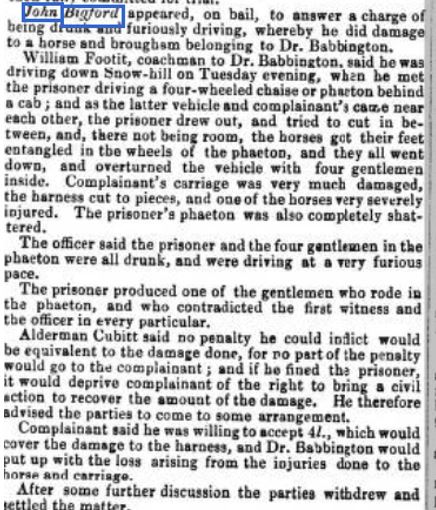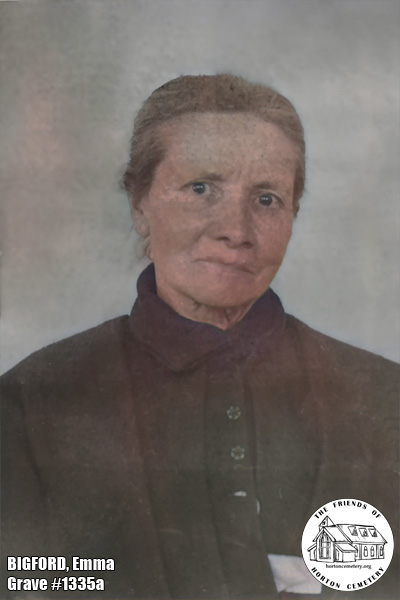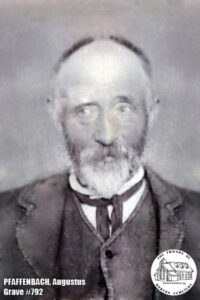b.1838 – d.1912
Early life – 1830s to 1840s
Emma was born on 14th April 1838 in Paddington and lived to be nearly 74 years old, dying on 20th January 1912 in The Manor Hospital. She was baptised in St John’s Paddington on 11th May 1838.
Her parents were John Bigford and Mary Ann Cummings, who married on 8th February 1835 in St George’s church, Hanover Square. Emma’s father is described as either a groom or a coachman in the earliest documents, but later is a coal agent or pitch and tar merchant. He was born in Hyton, Shropshire; Emma’s mother was born in Wimbledon.
In her younger days Emma worked as a shop assistant and never married. She seems to have lived at home with her parents for most of her life, according to the censuses.
Emma had 3 siblings. An older sister, Elizabeth, born in 1836 and younger brothers John George, born on 21st May 1841 and Charles born in 1843. Sadly, her brother John died in 1843 when just a toddler; Charles died in 1844 aged just 8 months.
1840s – 1850s
The 1841 census shows the family living in Prospect Place, Wimbledon and John is described as a coachman.
Emma’s sister Elizabeth went on to marry Joshua Westmoreland in 1860 and had 2 sons. There is a family tree on Ancestry.co.uk that suggests there are living relatives in that family.
By the date of the 1861 census the family is living in Rose Lane Stepney and John is a coal merchant. In 1871 the family is still living in Stepney but has moved to 9 York Street and has a lodger.

By the time of the 1881 census Emma’s sister Elizabeth, her husband John, a coachman, their son Robert 18, a Dock Clerk, Joshua (jnr.) 16, a Lighterman’s Clerk, Emma 42, a Shop Woman, her father John 74, now a Dealer in Pitch and Tar and her mother Mary Ann are all sharing the house.
The 1891 census shows just Emma and her brother-in-law Joshua, now a bus driver, living in the York Street house. Joshua’s sons had either married or moved on.

Emma was admitted to The Manor Hospital on 12th December 1899 and spent the next 12 years there, dying in 1912. Emma was buried in Grave 1335A. There is nothing yet to indicate the condition that resulted in her admission.

However, there were a number of deaths in the Bigford family in the 1880s that may have led to her having to be sent to The Manor Hospital. Her mother died in 1881 aged 69 and her father died in 1885 aged 78 followed by her sister, Elizabeth, in 1888 at the age of 52. That left Emma without any close family, apart from a brother-in-law with whom she apparently remained living for a while.
By the date of the 1901 census Joshua was living with his son, Robert, in East Ham. He died in 1907 in the Lewisham Union Infirmary at the age of 75.
Author’s thoughts
It’s not known whether Emma had some sort of mental or intellectual problems almost from birth, or whether they came on in later life following all the deaths in her family in the 1880s. Perhaps that caused her such distress that she was eventually admitted to The Manor Hospital.
She did live with her brother-in-law for a while, after her sister died, but we don’t know for how long or in what circumstances and why this had to come to an end. Joshua did live until 1907 and was something like 75 years old when he died so he seems to have been relatively healthy.
Emma’s family’s earlier years
The 1841 Census shows the family living in Prospect Place, Wimbledon. John Bigford is described as a coachman in that document. As far as I can establish, Prospect Place was a grand house occupied by a wealthy family (possibly Lord Cottenham’s family). The property was sold to developers in 1851 after which the Cottenham Park estate was built. Lord Cottenham died in 1851.
Did Lord Cottenham’s death result in the sale of Prospect Place, perhaps to pay Death Duties? Was John Bigford a coachman for this family and therefore lived on the estate? Did he lose his job and home when the property was sold resulting in the family moving to Stepney, and John changing his occupation? Unfortunately I could find nothing at all for the Bigford family on the 1851 census that might shed any light on this.

There is a press cutting from 1853, but it’s not possible to say for sure that this refers to Emma’s father. If it does though, it might explain his change of occupation by 1861. Maybe after such an incident he could no longer find work as a coachman.
Emma must have found it difficult to be in a position where she had no living blood relatives and, more than likely, no money to pay for her keep. If she did have lifelong problems then The Manor Hospital was probably the only place suitable for her. Let us just hope that the years she spent in The Manor were at worst comfortable and at best happy.




